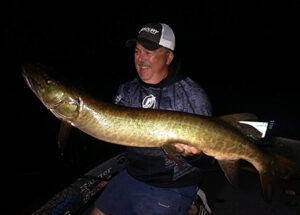By Steve Heiting
The goal for the evening was to catch a single musky — a daunting task any time, but one that was becoming increasingly difficult as a northwest wind ushered a cold front across northern Wisconsin. It was time for a crankbait.
I was fishing with Jim Saric, host of “The Musky Hunter” TV show, and northwoods guide Kevin Schmidt, and we were trying to wrap up filming for an episode of Jim’s show which will be broadcast early in 2022. We had caught five muskies during the previous two days, but since a couple were on the small side Jim felt the show “needed” one more nice fish to be special.

Under these same conditions, a five-inch jointed crankbait fished with a slow, steady retrieve has proven successful for me, so I dug one out of my tackle box and told Jim I would stick with it until dark. Normally I like to fish larger crankbaits with lots of rips and twitches to trigger muskies, but with the cold front marching through I felt a more subtle approach was required.
No muskies showed themselves as we fished where schools of ciscoes were revealed by the boat’s electronics. As darkness settled in and with time for only a few more casts, my crankbait was suddenly slammed by an unseen force no more than 30 feet from boatside. My instant hookset locked me into a struggle with a powerful fish that wanted to slug it out under the boat and away from the video camera’s bright light.
After a fight that seemed longer than it really was, the musky splattered the surface with its thrashing and Jim moved quickly with the net. Once again, a crankbait had produced when conditions were tough, and another episode of Jim’s show was complete.
In musky fishing, big spinners with sparkly tails, thunderous topwaters, and subtle soft plastics have become the rage. But when conditions are not ideal, crankbaits trigger fish in ways no other lure type can match. Crankbaits are usually the first choice of trollers, but any musky angler looking to improve his skills needs to also know how to fish them with a casting presentation.
Crankbaits, once known simply as “plugs,” are the workhorses of the musky tackle box because they’ll dive down and get the job done, often when nothing else will. Typically they have a plastic or metal lip attached to or molded into a plastic or wooden body. (There are also lipless crankbaits, but discussion of them will require another article.) As they are retrieved, the lip drags in the water, which causes the lure to dive and wiggle.
The angle and length of the diving lip determines how deep a lure will run. A short lip that is about 45 degrees or so to the lure’s body will typically cause the bait to run shallower. These lips are usually found on flat-sided crankbaits, often called “minnowbaits,” which will run two to four feet deep. Their flat sides produce lots of flash, so they’re best when fished with a twitching retrieve. Expect muskies to hit the bait during the pause between twitches. Lures of this type include Grandmas, ShallowRaiders and Slammers, among others.
Crankbaits with a longer diving lip that is more parallel to the lure’s body will dive more deeply, usually six to 10 feet. This factor alone helps when muskies are in a neutral or negative mood because the lure goes to them. Often, “deep-divers” as they are sometimes called, are fished with a steady retrieve. They can get additional action by bumping into cover or structure, such as weeds, timber, rocks or the bottom of the lake. Still, it’s always good to add a twitch or pause periodically throughout the retrieve to show a following musky a move it probably didn’t expect. The angle of the diving lip tends to shield the hooks from cover, and lures that have buoyant tail sections can be really good at this because they will back out of hang-ups when given slack line. Lures in this category include the Cisco Kid, DepthRaider and Triple D, and others.
Most crankbaits are available in several sizes. As a general rule, pick smaller crankbaits for early season fishing, as well as in pressured situations or following the passage of a front. Larger crankbaits are made to get noticed and should be used when muskies are more active, are suspended in deep water, or at night.
Choosing between jointed or straight models of some crankbaits comes down to the situation or an individual angler’s preference. A jointed crankbait looks like it’s moving faster than it really is, while a straight model usually has more buoyancy and is easier to use around weeds.
Crankbaits may contain rattles which range from BB-size to larger lead balls, which help attract muskies in stained or dirty water, in bloom or at night. Some anglers prefer crankbaits without rattles in extremely clear water.
Like any other lure type, crankbaits are easier to fish with the right tackle. For crankbaits measuring eight inches and larger, I prefer an 8-foot-6 heavy action rod rigged with a baitcasting reel with a retrieve ratio of around 5:1. I load this up with 80- or 100-pound test braided line, and a 130-pound test fluorocarbon leader. For smaller crankbaits, I choose an 8-foot-6 medium-heavy action rod with the same style reel, but loaded with 65-pound test braid. A lightweight “twitchbait” leader will produce better action because smaller crankbaits typically have less buoyancy.
Crankbaits should be in your arsenal because they can produce muskies when nothing else will.
